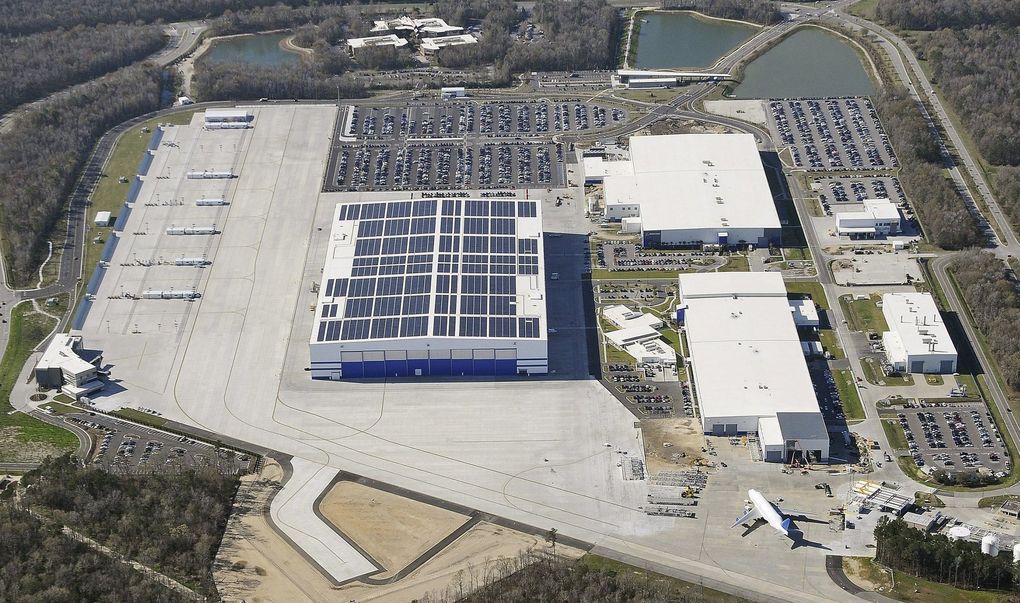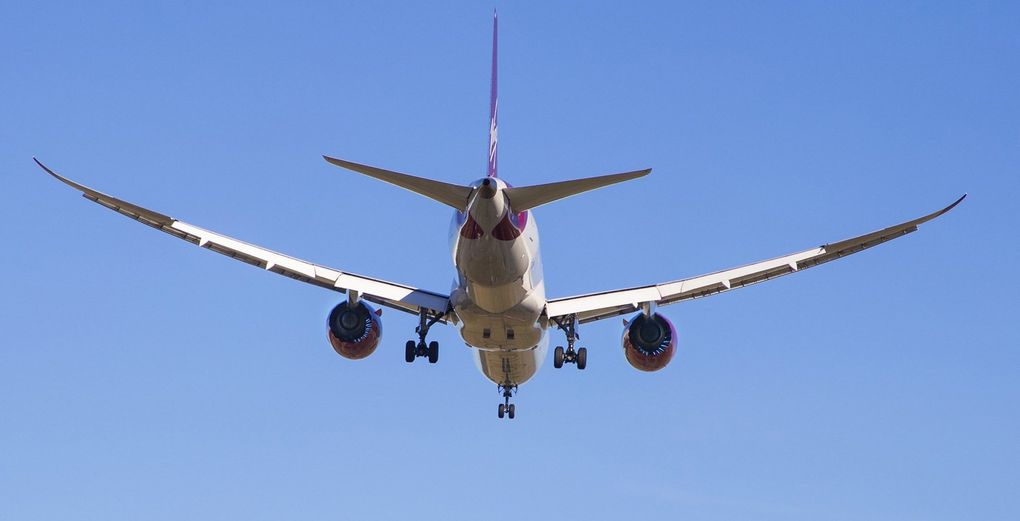Hit hard by the collapse of the airplane market, Boeing will decide as early as next month whether to consolidate its two 787 Dreamliner assembly lines in Washington and South Carolina at a single site. If it does, the 30,000-employee widebody jet plant in Everett is expected to be the loser.
That decision would have dire consequences for Boeing’s local workforce, and the regional supplier network that directly employs as many as 10,000 others.
Such a scenario has haunted employees and community leaders since Boeing shocked the region in 2009 by announcing it would build its second 787 assembly line in North Charleston, S.C. — its first jetliner plant outside Washington state.
“It’s a continuation of the strategy put in place years ago to not be as dependent on Puget Sound. Over the long haul, the idea was we’d consolidate there,” said a former senior Boeing leader, who asked not to be identified so as to speak freely. “We assumed there’d be other work to backfill Everett with.”
But now, with the pandemic triggering a collapse of demand for airplanes and Boeing’s finances already drained by the 737 MAX crisis, there is no new airplane launch on the horizon to compensate if 787 production is lost.
In 2003, this state’s political and union leaders mobilized to win the original 787 competition. In 2011, they did it all over again for the 737 MAX. In 2013, Boeing forced what became a bitter fight with labor to secure the 777X.
Now another momentous Boeing decision looms that may add substantially to the heavy job losses already announced and could lay waste to this state’s world-renowned aircraft manufacturing sector.
Yet there’s been little public action by political leaders, who feel the grip of the pandemic on aviation reduces their room to maneuver.
Losing the 787 assembly line “would be devastating for our local economy,” said Everett Mayor Cassie Franklin.
When Franklin and Snohomish County Executive Dave Somers spoke with Boeing’s top government affairs executive Tim Keating in Washington, D.C., he pointed to the significant capital investments Boeing has made in Everett as evidence of long-term commitment.
But Franklin said Keating was “cautious and guarded” as to how the 787 consolidation decision will go.
At Boeing’s request, the aerospace tax breaks the state lavished on the company in 2003 were eliminated in March to comply with World Trade Organization rules. So financial incentives are no longer an option.
Rep. Rick Larsen, D-Everett, who chairs the Aviation Subcommittee of the U.S. House Transportation Committee, said “the decision is out of the control of a lot of elected officials because it’s driven by this virus.”
“It’s a bit scary. It’s frustrating,” Larsen said. “There’s not a lot of actions we can take to sway the decision.”
‘Unwavering’ presence?
After dialing down production of the 787 to just six planes per month between its two sites, Boeing last month announced it would study consolidation of the work at one plant.
If Boeing were to consolidate in North Charleston, it would leave the largest building by volume in the world — housing Everett’s widebody jet final assembly lines — almost an empty shell.
Just two low-rate active assembly lines would be left after 2022, building at most five 767 and 777 airplanes a month for several years, down from the 15 jets per month that Everett pumped out a year ago.
State Employment Security Department data shows that last year — when Everett delivered a total of 173 widebody jets — aerospace manufacturing at Boeing and its suppliers together directly employed 41,000 people in Snohomish County.
Output sinking as low as 60 jets a year would dramatically slash employment.
Jon Holden, district 751 president of the International Association of Machinists (IAM) union, said those jobs are critical to the region’s manufacturing economy.
“We feel strongly that our membership and our community have already earned these jobs,” said Holden, recalling that the union lobbied for the 2003 tax incentives and his members then overcame enormous assembly problems caused by Boeing’s far-flung global suppliers to finally get the jet program on track.
That allowed Boeing last year to boost 787 production to an unprecedented level for a widebody aircraft: Seven planes per month at each of the two assembly sites.
“After all this effort, investment and support, it is disappointing to say the least, to see these jobs in jeopardy once again,” Holden said.
On Wednesday, Stan Deal, CEO of Boeing Commercial Airplanes, and Greg Smith, Boeing executive vice president and chief financial officer, took questions from worried members of the Washington state congressional delegation on a conference call.
Rep. Larsen, who participated, said Deal offered reassurance that “our presence in Washington is unwavering.”
Yet the two top Boeing executives gave no hint of the outcome of the 787 consolidation study.
Larsen said Deal and Smith told the delegation Boeing wants to hear from the IAM what suggestions the union can offer within the current contract terms for further “efficiencies and flexibility in production.”
Because Boeing rammed through an IAM contract change that froze the Machinists’ pensions to secure the 777X for Everett, this time around Boeing cannot directly ask for contract changes.
The IAM’s Holden said the union has had “no discussion with Boeing about their study … or how we can impact their decision.”
After those bitterly fought 2013 negotiations, the union changed its constitution to prevent its leadership from ever again entering into mid-contract talks without first getting approval in a vote of the full membership. Secret talks are off the table.
Like the politicians, the workers whose jobs are at stake may have limited input on Boeing’s decision.
Not a temporary move
With the impact of the pandemic on air travel and jet orders, Boeing has cut 787 production to just three per month on each coast.
Since each plant is capable of making that many on its own, consolidation is logical. “Frankly, it’s the right business decision,” said Bainbridge Island-based aviation analyst Scott Hamilton of Leeham.net.
Boeing, in a statement to The Seattle Times, said, “We have to consider solutions that allow us to be more efficient.” Its study to decide whether 787 consolidation is feasible is expected to be completed around the end of September.
When CEO Calhoun announced the study in late July, he made clear that if the decision is made to consolidate, it won’t be a temporary move just for when production is low. Boeing would consolidate only if its study shows the chosen site will be able to ramp up to meet full expected demand after a recovery — 10 to 12 airplanes per month.
“We’re not trying to solve for six airplanes,” Calhoun told journalists that day. “We’re trying to solve for a robust market and robust demand for the 787.”
If Boeing concludes neither site could handle such a production ramp, it could decide to stick with two assembly sites and continue to run each at the extremely low rate of three jets per month.
Boeing said that in making its decision it will “keep an eye on future requirements” and “the long-term health of our production system.”

Charleston’s edge
While Boeing’s narrowbody jet plant in Renton builds smaller single-aisle 737 MAX airplanes largely for domestic travel, the Everett plant builds Boeing’s entire lineup of widebody jets — currently the 747, 767, 777 and 787 airplanes, designed for long-haul international flying.
Boeing says it will shut down the 747 jumbo jet line in 2022. The 767 line currently produces just three planes per month, only cargo planes and the Air Force’s KC-46 air-to-air refueling tanker.
The 777 line has been preparing for the introduction of a new derivative under development, a giant plane called the 777X. But its service debut is now delayed until 2022 and the biggest jets have lost favor with airlines, hitting 777X sales prospects hard.
Boeing will cut the 777 rate next year to just two jets per month. The 777X is unlikely to ever reach the 777 production rates of former years that peaked at 8.3 jets per month.
In contrast, the 787, after its early years of serious production snags and delays entering service, is now the wildly successful cash cow of the twin-aisle jet lineup. And because it’s a relatively smaller widebody, it’s expected to sell well again once the international airline market recovers from the pandemic.
A significant advantage for South Carolina is that in addition to the 787 final assembly line, it also has separate buildings where the large 787 mid-body and rear fuselage sections are separately assembled.
For 787s built in North Charleston, those sections are simply wheeled over to the adjacent final assembly building. For 787s built in Everett, those big sections have to be flown across the country on Boeing’s giant Dreamlifter cargo planes.
And for the 787-10, the largest variant, the 114-foot mid-body section is too long to fit inside the Dreamlifter. So the 787-10s can be assembled only in South Carolina.

The only future for Everett
If Boeing does consolidate the 787 in South Carolina, Teal Group analyst Richard Aboulafia said this state’s aerospace sector faces “a very damaging three or four years.”
In addition to the job losses from the 787 going away, the cost of producing the 767s and 777s will shoot up because the overhead costs at the giant plant will then be spread over many fewer airplane deliveries.
Boeing will have to absorb much of that extra cost, especially on the 767 tanker program, which is a fixed-price contract. Boeing’s feasibility study will have to factor in such consequences, including possible big accounting write-offs.
Despite that, the former senior Boeing leader expects the financial drain from maintaining two low-rate 787 lines will force Boeing to “just bite the bullet and go to South Carolina.”
What he worries about most is the loss of engineering knowledge if the jet maker, scrambling to survive the downturn, cannot muster the resources to follow up with an all-new airplane design for four or five years.
The 787 was the last all-new design, launched 17 years ago.
“If we don’t do a new airplane within the next few years, we’ll have forgotten a lot about how to do it,” the former Boeing senior leader said. “I worry about the atrophy of the skill set.”
Aboulafia agrees that Boeing badly needs to keep intact “the crown jewels of aerospace” — the airplane engineering design talent in this region.
He too believes that if Boeing takes the 787 away from Washington state, then an all-new jet program — likely a plane that’s a size bigger and more capable than Airbus’s runaway success, the A321 — is the only thing that could save the future of aerospace here.
“Building it in Everett would make enormous sense,” he said.
The problem is that rather than spending billions of dollars on a new airplane, cost-cutting will be paramount at Boeing until there’s a robust industry recovery from the pandemic. What happens to Everett in the interim?
Industry veteran Adam Pilarski of consulting firm Avitas thinks Boeing needs to go all out now to research and develop not a new conventional airplane but a new environmentally “green” design that could be launched around 2030.
He believes the engineering work to design such a radically new plane and develop the advanced manufacturing methods needed to mass produce it should be begun during the downturn, ideally in the emptied out space in Everett.
Such work will not require as many mechanics as does building the current jets, but it would employ a cadre of highly skilled engineers and technical manufacturing people.
“These are jobs that you can have around Seattle, less likely in South Carolina,” Pilarski said.
He thinks that’s the way Boeing can secure its future, “if it wants to stay in aviation.”
Still, that leaves the next few years here bleak with aerospace job cuts.
To minimize the losses, the state must rely on reiterating for Boeing the region’s historical strengths: a skilled aerospace workforce and a training pipeline to maintain it.
Emily Wittman, CEO of the Aerospace Futures Alliance, a trade group of industry executives and state economic development officials, said, “I’m not sure what the state or county could tell the company that they don’t already know.”
A Teal Group competitive economics study updated in 2019, commissioned by the two main Boeing unions and compiled by a team led by Teal Group’s Aboulafia, assessed each state in the U.S. for its business environment for aerospace manufacturing.
Accounting for costs, availability of skilled talent, infrastructure and other economic metrics, Washington ranked No. 1 by a considerable margin. South Carolina ranked 27th.
“It’s in Boeing’s interest to keep Everett viable,” said Mayor Franklin.
Dominic Gates: 206-464-2963 or dgates@seattletimes.com; on Twitter: @dominicgates.
